The following procedure describes the steps involved in configuring a
disk library.
Before You Begin
|
|
This feature requires a Feature License to be available in the CommServe® Server.
Review general license requirements included in
License Administration. Also,
View All Licenses provides step-by-step
instructions on how to view the license information.
|
To configure a disk library
|
| 1. |
Display
the Library and Drive Configuration window.
|
|
| 2. |
From the Library and Drive Configuration
window, click the Start menu, select Add,
then select Disk Library from the
shortcut menu. |
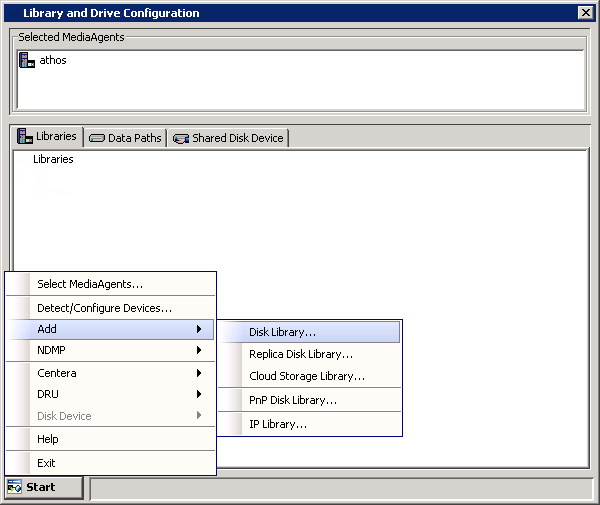 |
| 3. |
In the Add Disk Library dialog box,
add the following information:
Alias: A
descriptive name for the disk library.
Automatically create storage policy for new
data paths: Select this option to
automatically create a new storage policy when the mount path is added
to this disk library.
Click OK. |
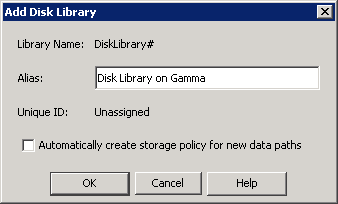 |
| 4. |
In the Add Mount Path dialog box, select
either Local Path or Network
Path.
-
Choose the Add new device.. option from the Disk Device
list.
-
If necessary add a name of the folder in which the library must be created
in the Base Folder box.
-
Choose the name of the associated MediaAgent.
-
If you select Local Path, click Browse
to select a mount path, or enter a mount path.
-
If you select Network Path, type the user
name and password to access the network share. Click Browse
to select a mount path, or enter a mount path.
|
For Unix MediaAgent, you can choose only
a local path. To access NFS share, you must mount
the share to your Unix MediaAgent. Once mounted, the share appears as another
local directory on the system and then you can provide this directory
location in the local path. |
- Click OK.
|
 |
| |
The mount path is added to the
specified location. When you add a mount path, the disk library appears in the
Library and Drive Configuration window with a status of configured. |
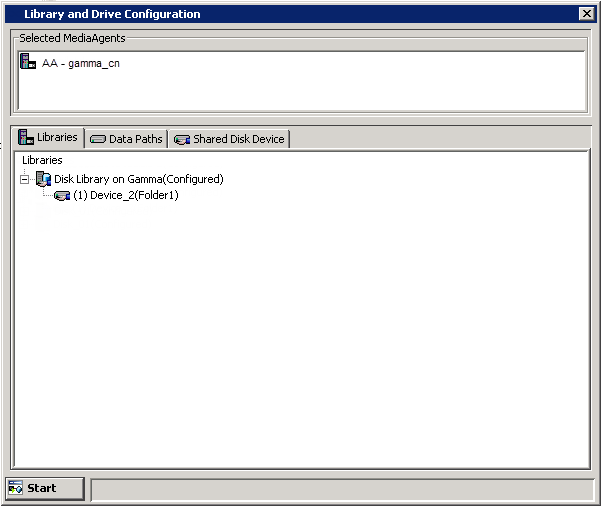 |
The following procedure described the steps involved in configuring automated
disk library.
| 1. |
From the CommCell Console, click the Tools menu and then
click Control Panel. |
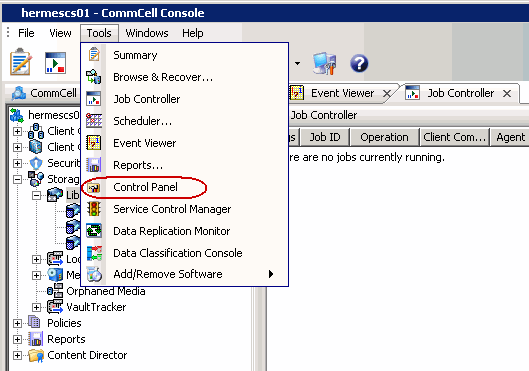
|
| 2. |
From the Control Panel, double-click the Library and
Drive Configuration. |
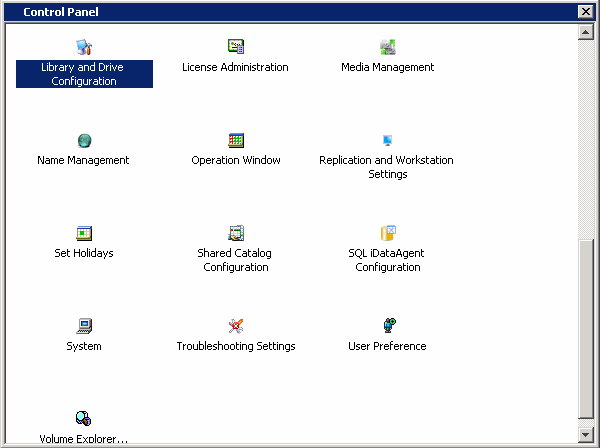 |
| 3. |
- Select the MediaAgent(s) whose devices you want to detect or display
from the Available MediaAgents list box.
- Click Add >> to move the MediaAgent(s) to the Selected
MediaAgents list box.
- Click OK.
|
 |
| 4. |
Click OK. |
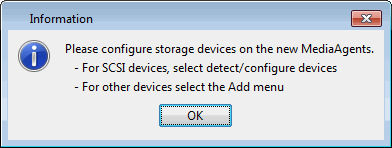 |
| 5. |
From the Library and Drive Configuration window,
click the Start menu, select Add, and then click Disk Library
with Automated Mount Path Detection... |
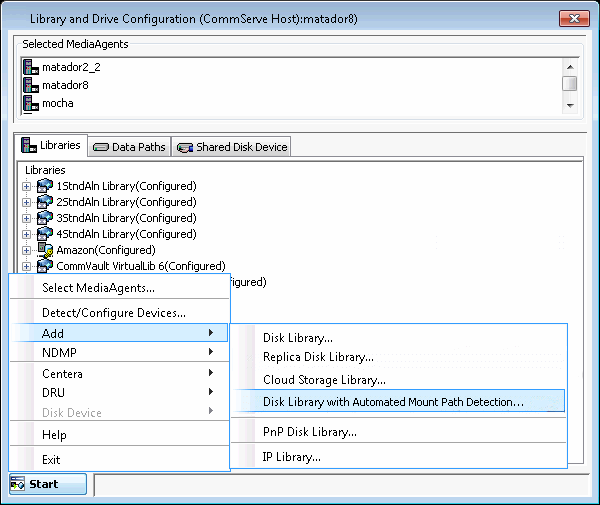 |
| 6. |
In the Alias box, specify name of the disk library
and then click OK. |
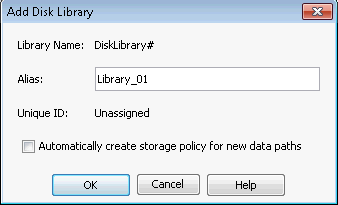 |
| 7. |
- From the MediaAgent list, select the MediaAgent.
- In the Folder box, type the mount path or click Browse
[...] to select a mount path.
|
If you need to share the volumes across MediaAgents, share the mount folder.
This will automatically share the newly added volumes. |
- Click OK.
|
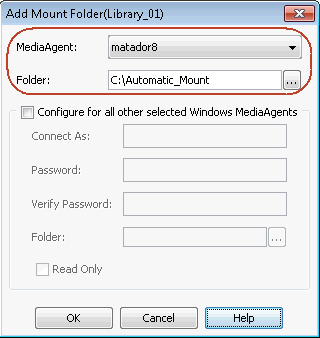 |
| 8. |
If you wish to configure mount path for all selected
MediaAgent(s), perform the following:
- Select Configure for all other selected Windows MediaAgents
check box.
- In the Connect As box, specify the user account
information.
- In the Password box, specify the password to access the mount
path.
- In the Verify Password, re-type the password.
- In the Folder box, type the mount path or click Browse [...]
button to select a mount path.
- Select Read Only check box, to give read only permission
to the mount path.
- Click OK.
The libraries will be shared between all MediaAgents
as per the mount folder specified at the time of configuration. |
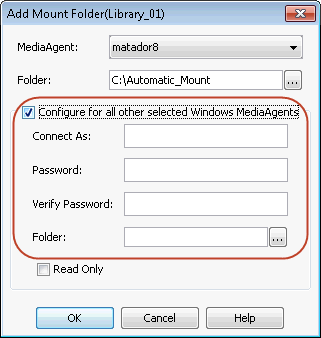 |
| 9. |
The mount path is added to the specified location. When
you add a mount path, the disk library appears in the Library and Drive
Configuration window with a status of configured.
|
If a MediaAgent is removed from the mount folder device list, it will not affect the
libraries already
configured. |
|
 |
| 10. |
Expand library to see the devices added to the mount
path. When a new LUN is mounted under the mount folder as a mount
point, the LUN will be automatically detected during next magnetic space
check and will create a new Device. |
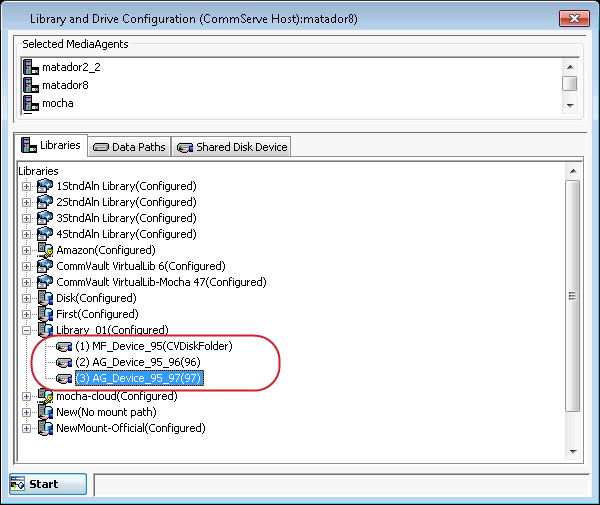 |
| 11. |
If you have configured multiple MediaAgent for the
mount path as described in step 8, then perform the
following to see the MediaAgents that are shared for the mount paths:
- Click Shared Disk Device tab.
- Expand the <Device>.
The MediaAgent(s) configured
with the device will be displayed. If you have configured MediaAgent
with read only permission, a lock
 icon will appear at the mount path.
icon will appear at the mount path.
|
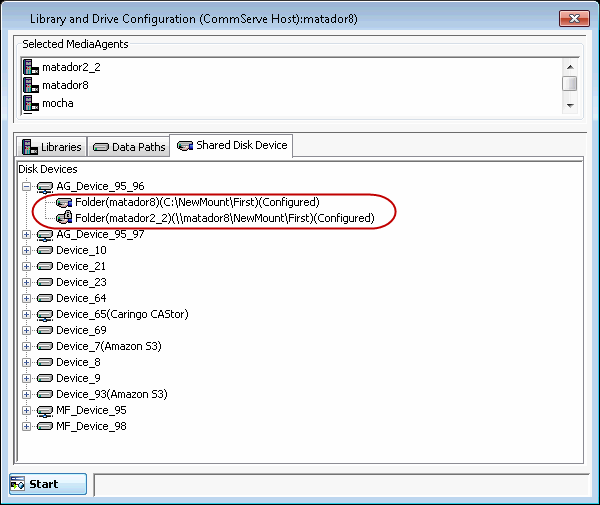 |
| 12. |
Also, you can set this Automatic mount path detection
configuration for existing library. See
Add Automatic Mount Path Detection for
step-by-step instructions. |
|
The following procedure describes the steps involved in configuring a shared
disk library with static mount paths.
Before You Begin
|
|
This feature requires a Feature License to be available in the CommServe® Server.
Review general license requirements included in
License Administration. Also,
View All Licenses provides step-by-step
instructions on how to view the license information.
|
To configure a shared disk library with static mount paths
|
| 1. |
Display
the Library and Drive Configuration window.
|
| 2. |
Click the Shared Disk Device tab. |
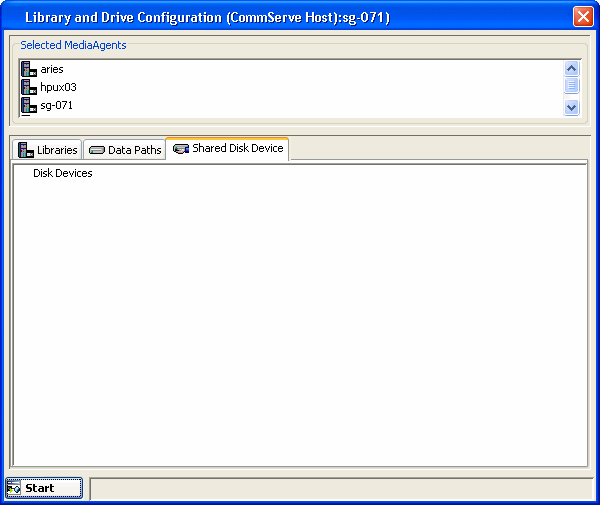 |
| 3. |
Click the Start menu, select Disk Device,
then choose Add Network Sharing Device. |
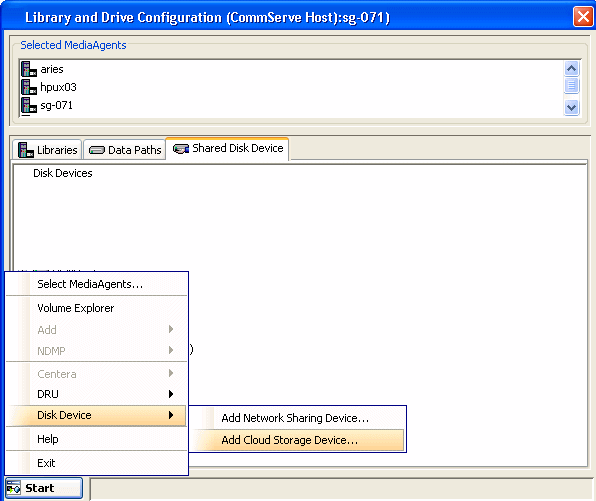 |
| 4. |
In the Add Sharing Folder dialog box, enter/select
the following information:
- MediaAgent - The name of the MediaAgent
accessing the mount path.
- Folder - The network path that will be used by the MediaAgent
to access the mount path
If the MediaAgent is a Windows MediaAgent, you can choose a local
path or a network path. If you use a network path provide the username and
password that must be used by the system to access the device.
If the MediaAgent is a Unix/Linux MediaAgent, then you can choose only
a local path. To access NFS share, you must mount
the share to your Unix/Linux MediaAgent. Once mounted, the share appears as another
local directory on the system and then you can provide this directory
location in the local path.
- When you are finished, click OK.
| |
When configuring a PolyServe File System, use the local PolyServe exposed
volume instead of using UNC paths as the folder. |
|
 |
| 5. |
The system displays the device information with the MediaAgent
accessing the device in the Library and Drive Configuration window. |
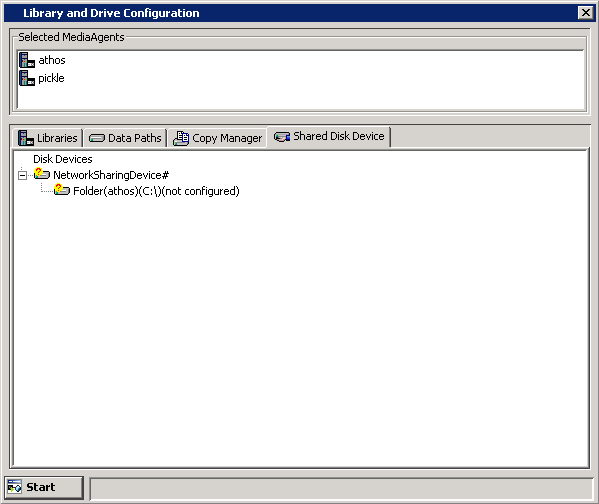 |
| 6. |
If you would like to add another MediaAgent to access the
device, right-click the appropriate NetworkSharingDevice and then
click Add Primary Sharing Folder. Enter/select the necessary information
in the Add Sharing Folder dialog box, as described in Step 4.
Repeat this step to add all the mount paths to the device.
|
 |
 |
Note that if the device is not configured at
this point, the detection information will not be saved when you exit from
the Library and Drive Configuration window. |
| 7. |
Right-click the Network Sharing Device
and then click Configure. |
| 8. |
Click Yes in the Confirm Configure prompt.
The status of the folders changes to configured.
|
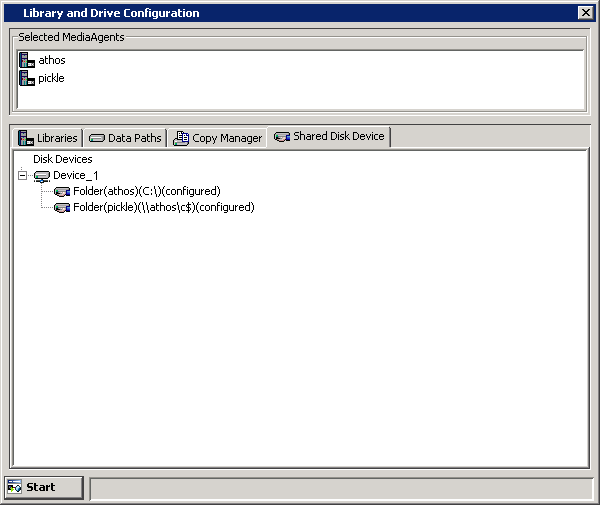 |
| 9. |
Optionally rename the Device Name with an appropriate name,
to avoid confusion. To rename, right-click the device and then click
Properties. In the Device Properties dialog box, type a new name.
|
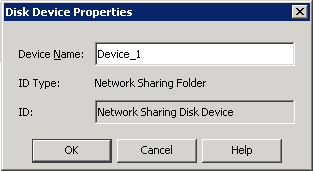 |
| 10. |
From the General tab of the Library
and Drive Configuration window, click the Start menu, select
Add, then choose Disk Library. |
| 11. |
In the Add Disk Library dialog box, enter the
following:
Alias: A
descriptive name for the disk library.
Automatically create storage policy for new
data paths: Select this option to
automatically create a new storage policy when the mount path is added
to this disk library.
Click OK.
|
 |
| 12. |
In the Shared Mount Path dialog box, select the
disk device that you wish to associate as the mount path from the Disk
Device list. In the Base Folder box, type the name of the base
folder under which the mount path can store data. Do not include the drive
letter while adding the name of the base folder.
Click OK.
|
 |
| |
The mount path is added to the shared disk library. |
 |
The following procedure describes the steps involved in configuring a shared
disk library with static mount paths.
Before You Begin
|
|
This feature requires a Feature License to be available in the CommServe® Server.
Review general license requirements included in
License Administration. Also,
View All Licenses provides step-by-step
instructions on how to view the license information.
|
To Configure Disk Libraries on Replicated Disks
|
| 1. |
Display
the Library and Drive Configuration window.
|
|
| 2. |
Click the Shared Disk Device tab. |
 |
| 3. |
Click the Start menu, select Disk Device,
then choose Add Network Sharing Device. |
 |
| 4. |
In the Add Sharing Folder dialog box, enter/select
the following information: MediaAgent - The name of the MediaAgent
accessing the mount path.
Folder - The network path that will be used by the MediaAgent
to access the mount path
If the MediaAgent is a Windows MediaAgent, you can choose a local
path or a network path. If you use a network path provide the username and
password that must be used by the system to access the device.
NOTES:
When you are finished, click OK.
Click No in the confirmation dialog box to add another sharing
folder. |
 |
| |
The system displays the device information with the MediaAgent
accessing the device in the Library and Drive Configuration window.
|
 |
| 5. |
Right-click NetworkSharingDevice and then click
Add Replica Sharing Folder. |
 |
| 6. |
In the Add Sharing Folder dialog box, enter/select
the following information for the MediaAgent residing on the replica sharing
folder. MediaAgent - The name of the MediaAgent accessing the mount
path.
Folder - The path that will be used by the MediaAgent to access
the mount path
If the MediaAgent is a Windows MediaAgent, you can choose a local
path or a network path. If you use a network path provide the username and
password that must be used by the system to access the device.
NOTES:
- Network path is not supported for
Disk Library Replication
solution; only local paths are supported.
- For Disk Library Replication solution, this is the destination sharing
folder and cannot be the same as the sharing folder path given in
Step 4.
When you are finished, click OK. |
 |
| |
The system displays the device information with the MediaAgent
accessing the device in the Library and Drive Configuration window.
|
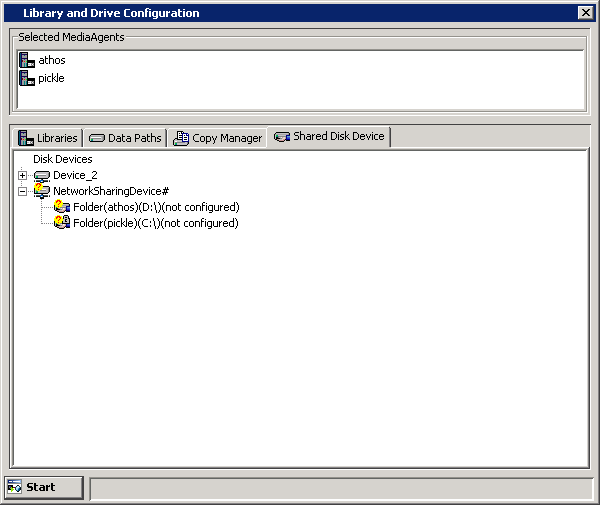 |
| 7. |
Right-click NetworkSharingDevice and then click
Configure. |
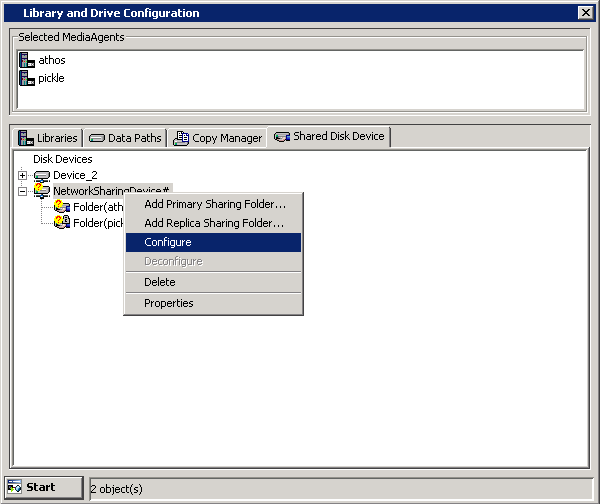 |
| 8. |
Click Yes to continue. |
 |
| |
The status of the folders changes to configured
in the Library and Drive Configuration window. |
 |
| 9. |
Optionally rename the Device Name with an appropriate name,
to avoid confusion. To rename, right-click the device and then click
Properties. In the Device Properties dialog box, type a new name.
|
 |
| 10. |
From the General tab of the Library and Drive
Configuration window, click the Start menu, select Add,
then choose Replica Disk Library. |
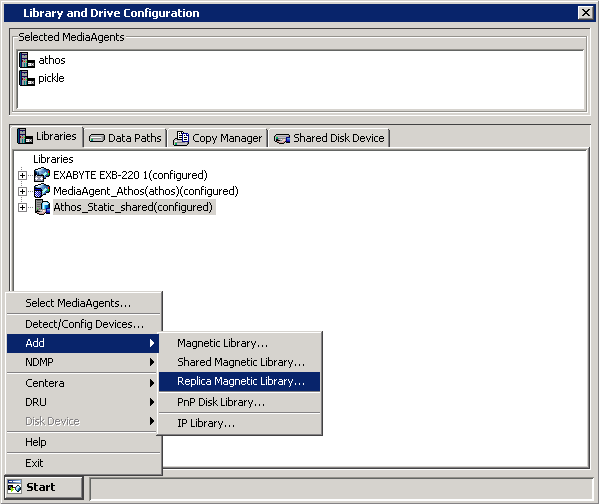 |
| 11. |
In the Add Disk Library dialog box, enter the
following:
Alias: A
descriptive name for the disk library.
Automatically create storage policy for new
data paths: Select this option to
automatically create a new storage policy when the mount path is added
to this disk library.
Enable Replication: For
Disk Library Replication solution, select this option to use
ContinuousDataReplicator to replicate data between the source (shared folder
added in
Step 4) and the destination (shared folder added in
Step 6) mount paths. Leave this option unselected if you are using a third
party application to replicate data between shared folders.
Selecting this option will automatically create a new replication set and a
replication pair under ContinuousDataReplicator, when a mount path is added to
this library. These replication sets and replication pairs can be monitored from
the CommCell Console. It is highly recommended not to change the default
settings of the replication sets, or delete the replication sets when the
replication is in progress.
NOTES:
Click OK.
|
 |
| 12. |
In the Shared Mount Path dialog box, select the
disk device that you wish to associate as the mount path from the Disk
Device list. In the Base Folder box, type the name of the base
folder under which the mount path can store data. Do not include the drive
letter while adding the name of the base folder.
Click OK.
|
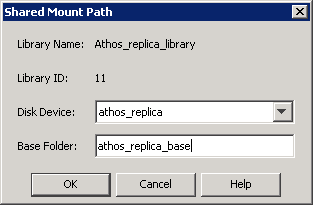 |
| |
The disk library is configured. |
 |




































